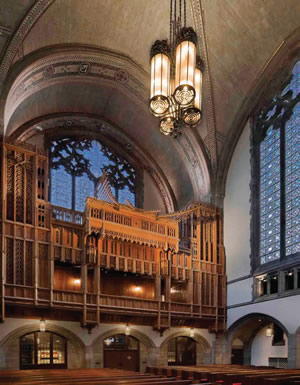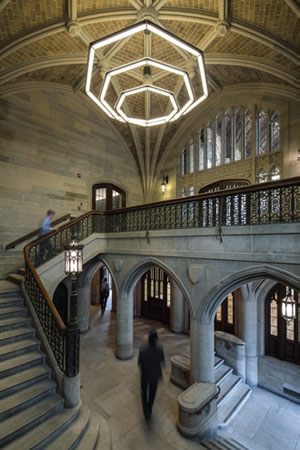The Lighting Master Plan

PHOTO © MARK BALLOGG PHOTOGRAPHY
Lighting is a fast-moving animal. Technologies, controls and energy codes change quickly, but does that mean your lighting protocols need to? And what about the master plan? Identifying and balancing interior and exterior lighting needs can be tricky, but keeping your campus safe, well lit and in step with student needs doesn’t need to be.
Design Standards vs. Master Plan
“Many higher education institutions have a set of design standards that pertains to lighting, but most do not have a true master plan,” says Robert Shook, FIALD, director, Schuler Shook Lighting Designers. The difference is huge. Design standards allow for efficiency, streamlining operations and maintenance. “Design standards, for example, may dictate that all linear fluorescent lamps be T5, in only 36- and 48-inch lengths and only with a color temperature of 3500K,” says Shook. Standards like these make it easy to efficiently maintain lighting throughout your school’s interiors.
A master plan, according to Shook, is “more visionary and speaks to the overall look and feel of the campus.” He states that the master plan usually pertains to the exterior but could touch on interior lighting as well. There is good reason to think holistically about lighting these spaces. New research shows that when looking at the interior, lighting designers and college stakeholders need to take the quality of light into account. “College students require lighting solutions that meet their agespecific needs,” explains Bruce Dunlop, principal, Bruce Dunlop Lighting Design LLC. “Due to the endocrines associated with late-state brain development, their circadian system is delayed by about an hour.” An interior lighting master plan that takes that physical difference into account can make students more successful.

PHOTOS © TOM ROSSITER
Setting the Standard
Lighting design standards will make life easier for your maintenance department. Limited choices mean less to stock, a nonexistent learning curve on installation and a completely coherent look and quality of light in the interiors. For instance, specifying a specific color temperature will keep your ceilings from looking like a mismatched checkerboard of blue-tinged and red-tinged lights.
The design standard is a great place to address the fast pace of lighting technology “Master plans should avoid adhering to any particular technology, but design standards may speak to this issue,” says Shook. He acknowledges that new technologies may be out of reach when first introduced and not always viable for schools that don’t want to be on the bleeding edge. Shook feels that a wait-and-see attitude towards new technologies is wise. “LEDs for general lighting have been around for 10 years,” he says, “but it’s only been in the past two to three years that the technology has stabilized to the point of full acceptance from most corners of the lighting world.”
Creating an interior that supports student learning is perhaps the most important aspect of lighting design standards. Speaking about the circadian systems of the young adult, Dunlop states that morning classes can be problematic. “The one-hour delay of their system[s] means that they have lingering melatonin in the blood stream,” he says. “This reduces alertness and cognitive function in the early morning hours.”

PHOTOS © TOM ROSSITER
The early morning class isn’t going away anytime soon. The right lighting, however, can ease young minds into a more wakeful state. “High color-rendering, cool-white light has been proven to suppress melatonin and improve morning brain function,” says Dunlop.
To this end Dunlop suggest specifying cool-white, high color-rendering light for teaching and learning spaces and moving to medium- or warm-white, high-color rendering sources for residential, dining and social spaces. He also suggests different horizontal and vertical foot-candles for classrooms, lecture halls, corridors and labs. Yes, this means that the design standard will get more complicated than just one or two choices, but creating the best learning environment is worth it. “To say that high-quality lighting improves student outcomes is not an overstatement,” he says.
Mastering the Plan
The lighting master plan is a different beast. “A good master plan includes guidelines for illuminating pedestrian paths, vehicular streets, building exterior facades and other prominent campus features,” insists Shook. “The goal of the master plan should assure safety, unify the aesthetic and enhance architecture while remaining mindful of the environment.” A good master plan should address the quality of light with color temperature and rendition while avoiding specifying particular technology. “Those issues are best left to the design standard,” says Shook.
Safety is one of the most important qualities of outdoor lighting, but schools must take care not to overwhelm an area. “There is such a thing as too much light,” says Shook. Sure, floodlights are inexpensive, easy to install and give the appearance of a well-lit outdoor space, but they also create glare and shadow edges and may not illuminate effectively for surveillance cameras.
Instead, Shook stresses the quality of light over quantity. “We have found that lower-wattage fixtures, scaled to pedestrians, can be a very successful tool in the master plan toolbox,” he says. That is not to say that floodlights have no place on a campus. “The only campus components that are usually floodlit are parking lots and sports fields,” he says. Still, he cautions that care should be taken to avoid unwanted glare.
Campuses with contemporary buildings may find the best outdoor light comes from within. “Many modern buildings, particularly those with large windows, do not lend themselves to being externally lit,” says Shook. “In those cases we often recommend that the interior lighting be designed and controlled to allow some light to stay on after dark, thus contributing to the safe illumination of the campus.”
Along with safety, outdoor lighting brings excitement to a campus, lending a school the opportunity to showcase impressive architecture. “We designers recognize that moms and dads tour the campus with perspective students and the lighting can accentuate the character of signature buildings, creating a strong sense of connection,” says Dunlop.
Lighting those older buildings presents very specific challenges.
“When renovating a historic building there is often a desire to preserve — or replicate — the original lighting fixtures,” says Shook. However, he cautions that as illumination levels were quite a bit lower than today’s expectations, he has figured out ways to supplement the historic fixtures. “We sometimes subtly insert small down lights into the most unobtrusive locations possible,” he says.
But for the most part, campuses have a mixture of old and new buildings. Shook suggests a protocol that celebrates the mix. He points to his work for the University of Chicago, where he used two distinct standards for the school’s post-top lanterns. The early 20th-century part of the campus uses a more historic lantern, while a modern fixture illuminates the newer section.
Once a lighting master plan is in place it should stay put, for a while at least.
“A good plan should avoid being outmoded by technology and instead describe the aesthetics of the fixtures and the quality of light,” says Shook. That being said, “any significant changes to the overall campus master plan should trigger a re-examination of the lighting plan,” he concludes.
This article originally appeared in the issue of .